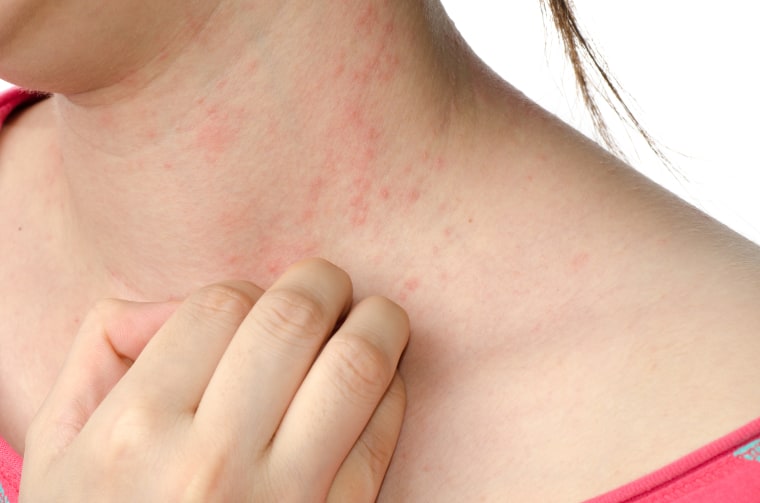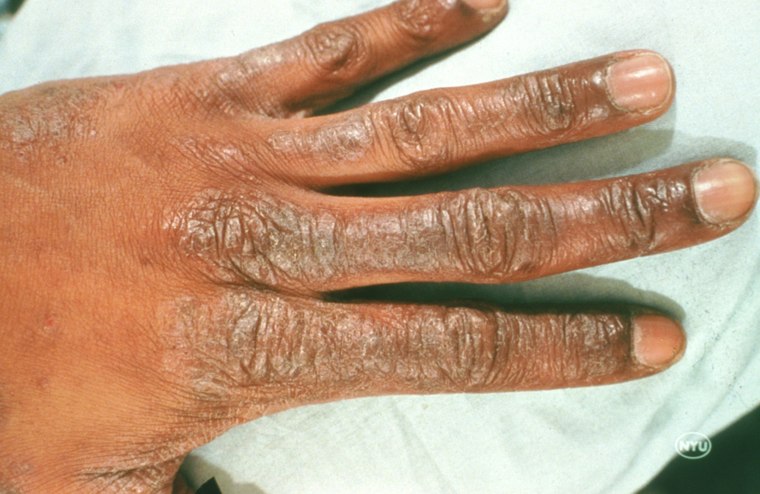What is contact dermatitis? Contact dermatitis is a reaction that occurs when something touches your skin and triggers a rash. The rash may appear right away or it could take some time to develop. Contact dermatitis is common — almost everyone gets it at some point.
“There are two main types — allergic or irritant (dermatitis),” said Dr. Allison Arthur, a dermatologist and dermopathologist at Sand Lake Dermatology Center in Orlando, Florida, and a member of the American Academy of Dermatology.
Allergic contact dermatitis develops when something touches your skin and an allergic reaction triggers a rash. “A classic example is poison ivy,” Arthur said. But there are more than 3,600 substances that can cause allergic contact dermatitis, according to the American Academy of Dermatology (AAD).
Irritant contact dermatitis is more common, and develops when something irritates the skin. It could happen after prolonged contact — diaper rash is an example. Even water can trigger irritant contact dermatitis with enough exposure. Toxic substances like acid, bleach and pepper spray quickly cause irritant contact dermatitis, according to the AAD.
Symptoms of contact dermatitis
With allergic contact dermatitis, you don’t always see symptoms right away. When they develop, you may notice one or more symptoms.
Symptoms of allergic contact dermatitis may include:
In rare cases, people can develop a severe allergic reaction. The AAD says you should get medical care immediately if you experience:
- Difficulty breathing
- Swelling in the face or eyes
- Confusion
Symptoms of irritant contact dermatitis may include:
- Dry or chapped skin
- Itchy, red skin
- Cracked, scaly skin
- Sores or blisters
Subtle redness that develops from contact dermatitis can be harder to detect in people with darker skin tones, said Dr. Laura Ferris, associate professor and director of clinical trials in the dermatology department at the University of Pittsburgh Medical Center and a member of the American Academy of Dermatology.
Causes of contact dermatitis
When contact dermatitis causes a lot of itchiness, like with poison ivy, people often have some idea what caused it, explained Ferris. Other times, it’s harder to identify the cause. “Makeup, skincare products and shampoo can cause contact dermatitis,” she said, “but they are more insidious and not as dramatic.”
One thing that’s less likely to cause your contact dermatitis? Laundry detergent, Ferris said, adding, “That’s a misconception. Everybody thinks it’s laundry detergent, but it almost never is.”
Common causes of contact dermatitis are:
- Poison ivy, oak and sumac
- Nickel, which you might find in cell phones, jewelry, zippers, belt buckles and as decorative elements on clothing or shoes
- Fragrances
- Latex
- Cement

Diagnosing contact dermatitis
To figure out how to treat contact dermatitis, your dermatologist will try to pinpoint the cause by examining your skin and asking questions. “Sometimes it’s clear from the history,” Arthur said. You may interact with cleaning products or strong chemicals as part of your occupation or hobbies, and see that when you touch those products you develop a rash.
A lot of different substances could cause a contact dermatitis allergy. Dermatologists can perform patch testing to identify the trigger that’s causing your contact dermatitis rash. They take a series of substances like fragrances and preservatives — things that you might find in shampoos, soaps, lotions and other things that touch the skin — and apply them to your back.
“We leave them on for a couple of days and monitor the areas to see if a reaction develops,” Arthur said. If it does, your doctor can let you know what substances to avoid, or recommend an app you can download that’ll generate a list of products containing that substance.
Treatment for contact dermatitis
Ideally, when it comes to treating contact dermatitis you want to avoid whatever is causing your rash. That’s why it’s crucial to identify the trigger. “You want to get the right answer, so you don’t buy 20 different detergents, only to find out it’s your shampoo,” Ferris said.

In terms of treatments for contact dermatitis, your dermatologist may also recommend antihistamine pills, moisturizers and topical steroids. For a more severe case you might need a stronger medication.
Contact dermatitis treatments should lead your rash to clear in one to three weeks, according to the AAD, although if you have your first case of poison ivy, oak or sumac, it could last up to six weeks.

